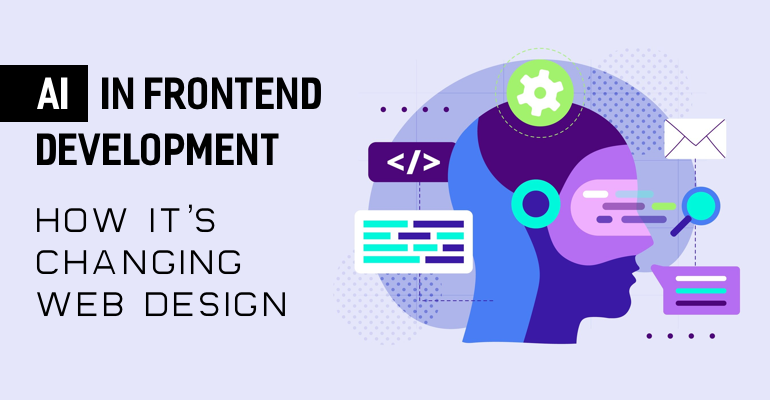The rise of Artificial Intelligence (AI) is revolutionizing frontend development and web design. AI-powered tools are making it easier for developers to create responsive, visually appealing, and highly functional websites. From automated code generation to AI-powered design recommendations, the integration of AI in frontend development is transforming how websites are built in 2025.
The Role of AI in Frontend Development
AI is enhancing frontend development by automating repetitive tasks, improving user experiences, and optimizing website performance. Here’s how AI is being used in modern web development:
- AI-Powered Code Generators
- Automated Web Design
- AI-Driven UX/UI Improvements
- Chatbots & Virtual Assistants
- Personalized Content & Adaptive Interfaces
- AI-Powered Testing & Debugging
- Performance Optimization
1. AI-Powered Code Generators
AI can automate frontend coding by generating HTML, CSS, and JavaScript code, reducing development time.
Example: GitHub Copilot
GitHub Copilot uses AI to suggest code snippets, complete lines, and even write entire functions based on context.
Example Code:
<!-- AI-generated Tailwind CSS button --> <button class="bg-blue-500 text-white px-4 py-2 rounded">Click Me</button>
Benefits:
- Speeds up coding process
- Reduces human errors
- Assists beginner developers
2. Automated Web Design
AI-powered website builders like Wix ADI and Framer AI can design entire web pages based on user input and preferences.
Example: Wix ADI (Artificial Design Intelligence)
- Users answer a few questions, and the AI automatically creates a website with pre-filled content and design.
- AI selects color schemes, fonts, and layouts based on industry trends.
Benefits:
- Eliminates the need for manual design
- Ensures mobile responsiveness
- Adapts to brand identity
3. AI-Driven UX/UI Improvements
AI analyzes user behavior and provides insights to improve UX/UI design.
Example: Heatmap Analysis with Hotjar
- AI-powered heatmaps track user interactions and clicks.
- Helps developers optimize layouts and improve navigation.
Benefits:
- Enhances user engagement
- Optimizes call-to-action placements
- Improves overall usability
4. Chatbots & Virtual Assistants
AI-powered chatbots provide instant support and improve customer interactions.
Example: AI Chatbot with Dialogflow
const chatbot = new Dialogflow();
chatbot.onMessage("Hello", () => chatbot.reply("Hi! How can I help you?"));
Benefits:
- Enhances user experience
- Reduces customer service workload
- Provides real-time responses
5. Personalized Content & Adaptive Interfaces
AI enables dynamic content delivery based on user preferences and browsing behavior.
Example: AI-Powered Recommendation Engine
- Netflix & Amazon use AI to recommend movies and products based on user activity.
Example Code (JavaScript for Dynamic Content):
if (userInterest === "Web Design") {
displayContent("Top Web Design Trends 2025");
} else {
displayContent("Learn Frontend Development");
}
Benefits:
- Boosts user engagement
- Increases conversions
- Improves retention rates
6. AI-Powered Testing & Debugging
AI helps in automated testing, debugging, and error detection to ensure high-quality frontend code.
Example: Selenium for Automated Testing
from selenium import webdriver
browser = webdriver.Chrome()
browser.get("https://example.com")
print(browser.title)
Benefits:
- Identifies UI bugs faster
- Ensures cross-browser compatibility
- Improves testing efficiency
7. Performance Optimization
AI analyzes website performance and suggests improvements for faster loading times and better SEO.
Example: Google PageSpeed AI Analysis
- AI-powered tools analyze Core Web Vitals and suggest optimizations.
Example Optimization with Lazy Loading:
<img src="image.jpg" loading="lazy" alt="Optimized Image">
Benefits:
- Boosts page speed
- Enhances user experience
- Improves SEO rankings
The Future of AI in Frontend Development
AI is shaping the future of web development, and we can expect:
- AI-generated websites that adapt in real-time
- Advanced AI-driven UX personalization
- Smarter AI coding assistants
Conclusion
AI is transforming frontend development by automating coding, improving UX/UI, personalizing content, and enhancing website performance. Developers who leverage AI tools will stay ahead in 2025, creating smarter, faster, and more efficient web applications.


One thought on “AI in Frontend Development: How It’s Changing Web Design”